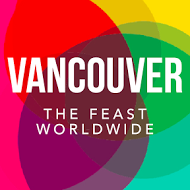 I’ve been reading Animal, Vegetable, Miracle (Barbara Kingsolver) this summer, which puts great emphasis on how food — specifically local in the case of this book — brings people together, in celebration and as part of their culture. With that in mind, I’m pleased to tell you about an upcoming, worldwide event that uses the occasion of dinner toward making positive change. (Two of my favourite things in one — how could I resist?)
I’ve been reading Animal, Vegetable, Miracle (Barbara Kingsolver) this summer, which puts great emphasis on how food — specifically local in the case of this book — brings people together, in celebration and as part of their culture. With that in mind, I’m pleased to tell you about an upcoming, worldwide event that uses the occasion of dinner toward making positive change. (Two of my favourite things in one — how could I resist?)
The Feast Worldwide Vancouver
Saturday, October 18th
Groundswell Cafe & Learning Space
The Feast Worldwide is a day of global dinner parties in 40+ cities across 6 continents. The goal? To spark collaboration that drives local entrepreneurs and social initiatives forward.
On October 18, we’re inviting Vancouver to explore the global theme of progression through food and sharing. Join us in envisioning, “A world where growing and eating healthy food connects people.”
The idea is simple. Come for an interactive dinner that explores connections between food, community, technology, sustainability, business, health, design, and more! We’re inviting incredible entrepreneurs to share their work to inspire greater discovery and ideas. Let’s sit together over dinner — and instead of talking about problems, talk about ways to support each other, collaborate, and make things work better.
Register at Eventbrite and follow the Feast on Facebook for updates.
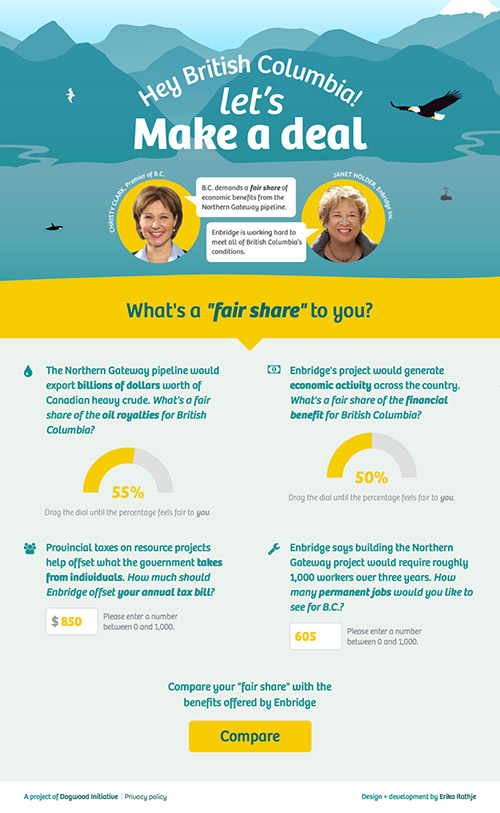
I’m really excited to share with you a website I designed for Dogwood Initiative, which launched this week. Fair Share BC asks a simple but vital question: What’s a fair share of economic benefits for BC of Enbridge’s Northern Gateway pipeline? Whether you’re against the proposed pipeline — as are about three quarters of British Columbians — or for it, or agnostic/undecided, we’d like to hear your opinion.
Understanding that many of us would never put a price on our coast, the main purpose of the site is two-fold: to enable the people to decide what a fair share looks like, and to help conversations happen between folks with different view points. (Maybe Uncle Bob wants more permanent jobs for BC, but thinks we’d get a lot more than we would in reality?) I’d consider myself well-informed, and was surprised by the actual numbers.
Prime Minister Harper’s decision on the Northern Gateway project is anticipated soon. If he gives it the green light, it’s then up to Christy Clark to stand up for BC. But her “fair share of the fiscal and economic benefits” condition in the pipeline’s way is vague — what’s fair by her standards? Dogwood Initiative will collect the public’s Fair Share BC quiz answers (totalling over 2,000) to put some hard, public-powered numbers behind that. I want to make it clear that thinking about what a fair share looks like doesn’t mean we can be bought if we got what we asked for — the reality is that we won’t, so this is an exercise in making it clear that Christy Clark’s fifth condition cannot be met.
I worked closely with Kai Nagata, Energy and Democracy Director. Dogwood Initiative’s Karl Hardin and Joshua W provided technical heavy lifting for which I am grateful.
Additional ways to take action
Join over 16,000 people to send a message to the “Enbridge 21” — BC’s Conservative MPs who stand to lose a lot if the federal government approves the project. Encourage them to support BC instead of Enbridge.
Pledge to support a referendum on the future of pipelines and oil tankers in BC. If you have time, please consider volunteering in your community.
Send Christy Clark a message to stand strong for BC.
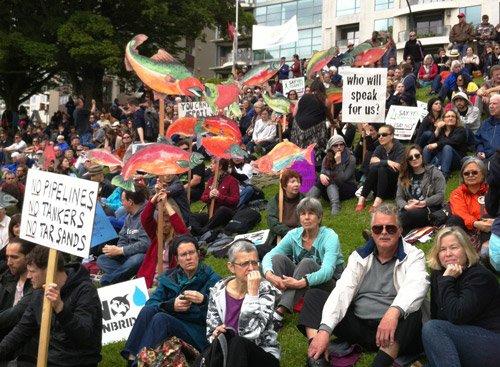
I still remember the staff meeting at the David Suzuki Foundation where I was on the verge of tears. I don’t remember what the sad news was, but the fourth person to speak was David, by phone from South America I think. It was such a devastating stack of news that maintaining composure was a challenge. It was on par with listening to Tsleil-Waututh elder Amy George speak about the Healing Walk and what has happened to their land in the last 150 years — land on which I grew up, too. Her words brought me to or very close to tears twice in one week.
This past Saturday, I spent the entire day with my non-profit friends, some of whom I have the sincerest pleasure of working with. We attended a conference called CanRoots, which was generally uplifting and closed with a standing ovation for two women from Kitimat’s Douglas Channel Watch. The feeling in the room and in my heart was extraordinary: all of us, united in our shared joy and passion, applauding and cheering for a small group of committed citizens who fought a Goliath and won. This is, I thought, a morsel of what it will feel like when British Columbians win.
When your work is to fight hard for something you care deeply about, your job is going to be full of emotion. It’s difficult to hear bad news — ice sheets melting, sea stars dying en masse, another pipeline approval, another loss for democracy. And it’s pure joy to celebrate our successes. But I know that some of my friends have a hard time with the slog. At the end of the day, though, I wouldn’t be doing anything else. I do this work, and I try so damn hard in my personal life as well, because I care so f*&%ing much. Our government calls us radicals and extremists, and we respond by standing taller and stronger. It would, though, be considerably easier to stop pipelines, curb runaway climate change, prevent our water from being destroyed in mining operations, and save the salmon if our provincial and federal governments cared like we do and understood what’s at stake. What we do to the planet, we do to ourselves.
So I’m going to keep throwing my heart and soul at this work. At a fairer democracy, at sustainable alternatives, at stopping new oil pipelines and LNG plants. I’m not a radical. I’m a human.
Want to join me? I just signed up as volunteer organizer for what I think is the best shot we’ve got at saving British Columbia from Enbridge. Sign the pledge to push for a fair, province-wide vote on oil pipeline and tanker traffic expansion in BC. And if you care like I do, I’d love for you to join me in collecting pledges in your community. Will you stand up for BC with me?
It can be difficult to grasp the scale of Edward Burtynsky’s subjects when there are no points of reference — no recognizable objects, intentionally no humans, and sometimes no horizon. Your understanding of what you’re looking at changes between close proximity and several steps back. Sometimes it’s better just to wonder, because comprehending the vast scale of a field of oil drilling rigs, Alberta’s oil sands or a coal mine in BC can take the wind out of you — at least, if you’re as affected as I am by these visuals. I left feeling pretty drained as it’s emotionally taxing to look at how we’ve shaped, polluted and destroyed the landscape of our planet to meet ever-growing needs. Not everything in the Vancouver Art Gallery’s exhibit of Burtynsky’s work was dark, but a bleak image of a massive pile of tires (at a distance, just a huge wave of black) burning after a lightning strike had me reeling and thinking, “what have we done?”
“In Burtynsky’s vernacular, the ‘manufactured landscape’ is no longer a simple contest of nature versus culture; instead his images suggest an emergent condition in which the natural world has been fully consumed, never to reappear again.” — Vancouver Art Gallery
I was standing in front of a large format aerial photograph of a Scottsdale, Arizona suburb when the woman next to me said, “this is the scariest one.” I don’t know if she’d been to the other side of the exhibit yet, but I understood what she meant. A rectangle of desert with a road around its perimeter marks the Navajo reserve, abruptly divided from suburbia, which is the usual unsustainable pattern: tendrils of cul-de-sacs, single-family houses — many with pools — tennis courts, and trees, all supported by a dwindling water supply. Far, far in the distance one can see a few towers in Phoenix, an unpleasant highway commute away. Now that I have time to absorb it, the connection between this and the rest of the exhibit is clear: the activity documented by Burtynsky feeds this horrific exercise in “community planning.” Artificially cheap oil, mining coal and metals, irrigating the desert — it’s all to feed an insatiable appetite called the American Dream.
I’ve been working for months on various campaigns working to shift away from Canada’s large-scale, rapid energy extraction, consumption and export economy, and toward green energy and jobs. Our opposition is wealthy and determined, and the media not always kind. Exhibitions such as Burtynsky’s, or similarly Chris Jordan (on consumption and waste), help to bring a real-life tangibility to what corporations and consumers are doing. It’s up to us to fight for the alternatives, and to be reminded of the ways in which we can meet reasonable needs responsibly.
To that end, here are a few ways you can get involved:
Sign the pledge to push for a fair, province-wide vote on oil pipelines and tanker traffic in BC
100 in 1 Day, Vancouver edition — multiple workshop dates culminating in 100 urban interventions on June 7th each in Vancouver, Toronto, Montreal and Halifax
CanRoots, May 23–24
10th anniversary screening of The Corporation, May 26th
The Edward Burtynsky exhibition at the Vancouver Art Gallery ends May 26th.
This relevant, eye-opening video poetry touches on something I think about every so often when I’m walking through the city. I see people staring at their phones as they pass by and wonder what potential relationships they just missed starting because they weren’t paying attention. While our attentions are so focused on not missing a beat on the internet, life is playing on without us, around us. Stop and look up. Be attentive to the world and its detail. What do you see, smell, hear and feel?
Now if you’ll excuse me, I’m going for a walk to the grocery store and leaving my phone behind my front door.
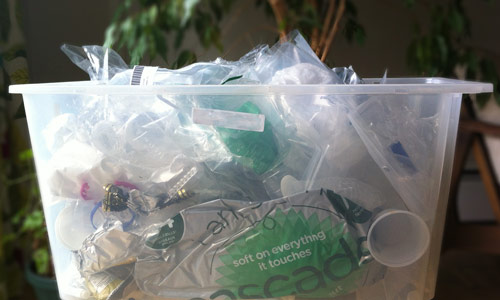
Before you start thinking I’m super gross and live in a pig sty, let me explain.
I’ve been keen on zero waste for a long time. I’m definitely a devoted recycler and composter, having grown up with both at home. But once I moved out I got to make my own choices about where my trash goes and how to keep it from showing up in the first place. Here’s my secret.
This is the most fun you’ll ever have recycling. There are tons of people at the depot. Assuming you pre-sorted your stuff into categories, once you’re there you just drop it into bins and have a chat with people. I usually pay a dollar to have three months’ worth of stuff recycled and the depot is a seven minute bike ride from home. Super convenient.
Continue reading I haven’t taken out the trash in six months »
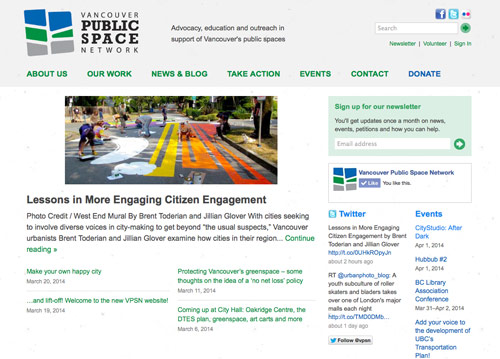
It’s with great pleasure that I share with you a project that was long in the making. Built entirely by volunteers, the new Vancouver Public Space Network website is a labour of love that began about three years ago. I think that extended anticipation made the ultimate launch that much more exciting for me and, I think, for them. It’s also amazing to consider how much technology has changed since our first conversation.
The Vancouver Public Space Network advocates for better public spaces and is responsible for such fun events as Parking Day and the annual Halloween SkyTrain Party and SeaBus pirates. (Not to be confused with the No Pants one. Although, I guess you could go without pants as Donald Duck if you wanted.)
As an advocacy organization, the VPSN works to champion the importance of public space to the overall liveability of the city. … Our work attempts to provide a blend of focused research and design work, creative community engagement and a celebratory, solutions-based approach.
I’m proud and honoured to contribute to the success of this important organization that works to improve our urban life. I’m grateful for Nicolas Demers‘ countless hours bringing it to life, and to a team that changed hands partway through and which pulled it all together so beautifully. Alissa, Jillian, Graham, Jessica, Andrew and the rest of you behind the scenes: thank you for taking this journey with me and congratulations! I can’t wait to see where you go.
Be sure to check out their upcoming events and please consider supporting the VPSN with a donation.
Got a project that needs design love? If you’re with a business or non-profit making positive impacts, I’d love to hear from you.
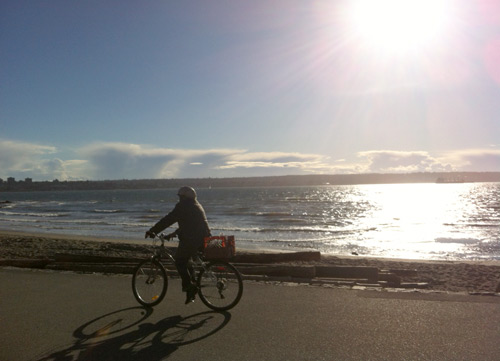
This is not me.
On Monday, a sunny day with a strong wind, I left a meeting with my new life coach close to five. I felt at once an obligation to head home — an internal guilt trip — and a desire to feed my bicycle-addicted brain. I was downtown already and compromising:
“You can’t go ride the seawall right now. You have things to do.”
“Like what? There’s nothing important to be done when I get home at 5:30.”
“I don’t know, you just need to go home. … Okay, you may take the short scenic route.”
“It’s a little farther but worth it.”
It took me awhile to relax and give myself permission to feel like I was free for the evening, that I didn’t need to go home and work.
Continue reading Shut up, work brain. I’m going to enjoy a bike ride. »
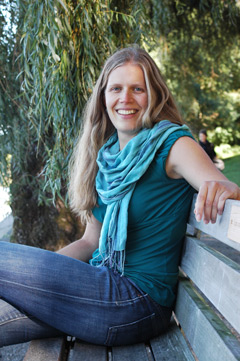
I’ve always cared a lot about our planet. I was the kid asking other kids not to dig all the clay out of the creek bed at our elementary school. I’ll never forget coming home from a trip at age nine to find a forest off the main road gone. Or at age ten seeing clearcut mountains on the way to Tofino. It hit home for me. I understood the issues. After all, this was the age of Captain Planet. But I think kids generally “get it.” I never understood why people litter (because garbage magically disappears, right?). I stomped on tin cans a lot to recycle them and was brought up to not waste food. I have an obsession with trees that’s visible in my drawings going back, well, forever.
Continue reading Designing for good: why I do what I do »
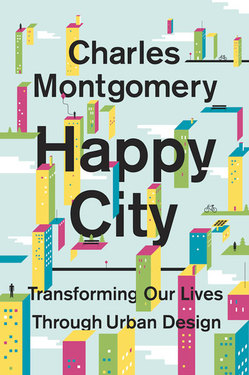
I felt sad when I finished reading “Happy City” the other day. Vancouver author Charles Montgomery weaves together stories, interviews, culture and information in such a compelling way that I felt like a month-long conversation had ended. When I began reading it, I gushed about it on Facebook and with good reason. It has something for any city dweller — from the history and science of happiness and behaviour, to impacts of transportation on wellbeing, to dwelling types influencing social interaction. I returned it to the library reluctantly after my initial 14-day restricted loan period was up, and waited anxiously to get it back until another copy was returned six days late. (I guess the other person liked it even more than I did.) I felt its absence like a close friend.
Continue reading What makes a Happy City? »
 I’ve been reading Animal, Vegetable, Miracle (Barbara Kingsolver) this summer, which puts great emphasis on how food — specifically local in the case of this book — brings people together, in celebration and as part of their culture. With that in mind, I’m pleased to tell you about an upcoming, worldwide event that uses the occasion of dinner toward making positive change. (Two of my favourite things in one — how could I resist?)
I’ve been reading Animal, Vegetable, Miracle (Barbara Kingsolver) this summer, which puts great emphasis on how food — specifically local in the case of this book — brings people together, in celebration and as part of their culture. With that in mind, I’m pleased to tell you about an upcoming, worldwide event that uses the occasion of dinner toward making positive change. (Two of my favourite things in one — how could I resist?)






